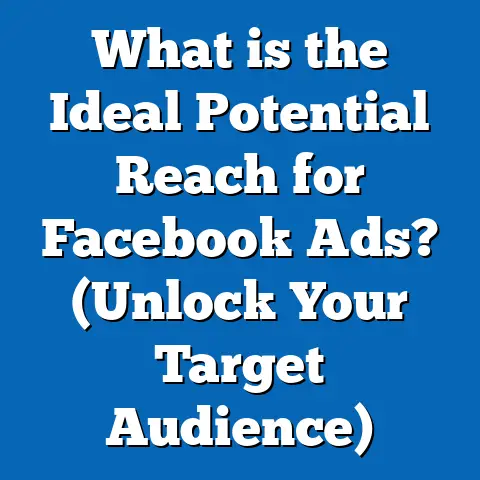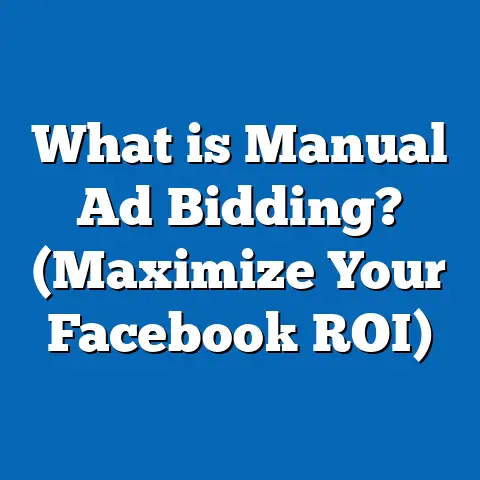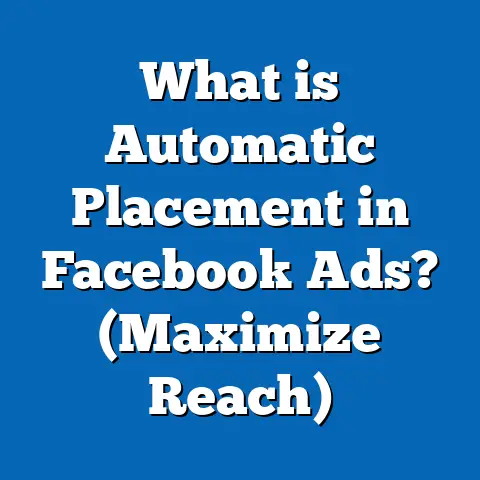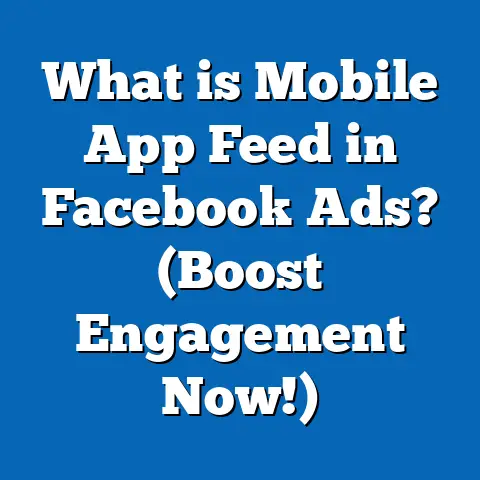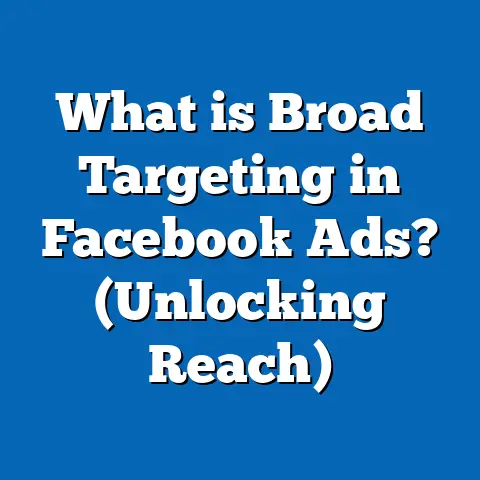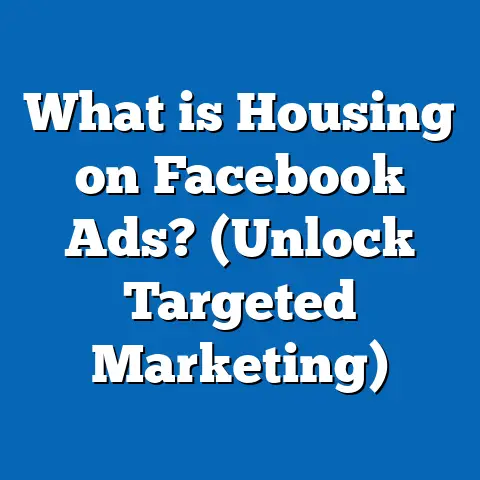What is Facebook Ad Cost for Small Businesses? (Optimize ROI)
What is Facebook Ad Cost for Small Businesses? (Optimize ROI)
Introduction: The Weather as a Metaphor for Advertising Conditions
Imagine waking up to check the weather forecast before planning your day. If it’s sunny, you might decide on outdoor activities; if rain is predicted, you grab an umbrella or reschedule. This simple act of preparation can save you discomfort and wasted effort. Similarly, in the world of digital advertising, understanding the factors that influence Facebook ad costs is like checking the weather forecast for your marketing budget. It guides your strategy, helps you avoid surprises, and ensures you invest wisely.
Facebook advertising has become a cornerstone for small business growth worldwide. But like weather patterns, ad costs fluctuate due to many variables—from audience competition and ad quality to seasonal demand and platform changes. This guide will help you understand these variables, interpret data trends, and apply proven strategies to optimize your Facebook ad spend and maximize return on investment (ROI).
Section 1: Fundamentals of Facebook Ad Costs for Small Businesses
1.1 What Are Facebook Ad Costs?
Facebook ad costs are the amount of money businesses pay to display their advertisements on Facebook’s platform, including Instagram and Audience Network (partner apps and websites). Unlike traditional advertising with fixed rates, Facebook uses a dynamic auction system where advertisers bid for impressions or actions (clicks, conversions).
Key Cost Types:
- Cost Per Click (CPC): Amount paid when someone clicks on your ad.
- Cost Per Mille (CPM): Cost per 1,000 impressions (views).
- Cost Per Lead (CPL): Cost to acquire a lead.
- Cost Per Conversion: Cost to achieve a specific action like a purchase or sign-up.
1.2 Why Facebook Ads Are Important for Small Businesses
Facebook has over 3 billion monthly active users across its apps (Facebook, Instagram, Messenger). For small businesses, this provides access to a massive audience with precise targeting options based on demographics, interests, behaviors, and more.
- Affordable Entry Point: You can start with as little as $1 per day.
- Localized Targeting: Reach customers in your city or neighborhood.
- Advanced Analytics: Track performance in real-time.
- Diverse Ad Formats: Images, videos, carousels, stories.
Section 2: What Influences Facebook Ad Costs?
Understanding what drives your Facebook ad expenses is crucial to managing your budget effectively.
2.1 Bidding and Auction System
Facebook runs ads through an auction where advertisers compete to show ads to the same audience. The winner isn’t just the highest bidder but the one offering the best estimated value to users.
Factors in Auction:
- Bid Amount: Maximum you’re willing to pay.
- Estimated Action Rates: Likelihood your ad will get clicks or conversions.
- Ad Quality and Relevance: Higher quality means lower cost.
2.2 Audience Targeting
The size and competitiveness of your audience dramatically affect costs.
- Broad Audiences: Generally cheaper CPC but less precise.
- Narrow Audiences: More competition leads to higher CPC but better conversion potential.
- Custom Audiences: Use existing customer lists for better targeting.
- Lookalike Audiences: New users similar to your best customers; usually more expensive but effective.
2.3 Ad Placement
Where your ads appear impacts price:
| Placement | Average CPM Range | Notes |
|---|---|---|
| Facebook News Feed | $7 – $12 | Highest engagement |
| Instagram Feed | $8 – $14 | Popular with younger demographics |
| Stories (FB & IG) | $6 – $10 | Short duration, high visibility |
| Audience Network | $4 – $8 | Lower cost but variable results |
2.4 Ad Quality and Relevance Score
Ads with higher relevance scores cost less because they deliver better experiences to users.
- Relevant ads get more clicks.
- Facebook rewards good ads with lower CPCs.
2.5 Campaign Objective
Your advertising goal influences cost:
- Brand Awareness: Usually cheaper CPM but less direct action.
- Traffic: Moderate CPC.
- Conversions: Often higher CPC but better ROI if optimized correctly.
2.6 Seasonality and Industry Trends
Costs rise during high-demand seasons such as holidays, Black Friday, or special events.
| Period | Typical Cost Impact |
|---|---|
| Holiday Season | +20% to +50% increase |
| Election Cycles | Can spike due to high demand |
| Off-Peak Months | Lower costs |
Section 3: Data-Backed Insights on Facebook Ad Costs
3.1 Average Costs by Industry
| Industry | Avg CPC | Avg CPM | Notes |
|---|---|---|---|
| Retail & E-commerce | $0.70 – $1.50 | $6 – $12 | Highly competitive |
| Finance & Insurance | $1.50 – $3.00 | $10 – $15 | Higher due to strict targeting |
| Health & Fitness | $0.80 – $2.00 | $7 – $13 | Popular industry |
| Technology | $1.00 – $3.50 | $8 – $16 | Complex products |
| Education | $0.60 – $1.80 | $5 – $11 | Cost varies by target audience |
Source: WordStream Q4 2023 report
3.2 Small Business Spending Patterns
- Average monthly budgets range from $200 to $1,000.
- Businesses that spend less than $500 monthly tend to focus on brand awareness or lead generation.
- Higher spenders prioritize conversions and retargeting.
3.3 Case Study: Small Business Advertising Spend vs ROI
A survey of 50 small businesses showed:
- Businesses spending around $500/month achieved an average ROI of 200%-300%.
- Those under-spending (<$100/month) often failed to see measurable ROI due to insufficient data for optimization.
- Proper use of retargeting boosted ROI by 3x compared to prospecting-only campaigns.
Section 4: Facebook Ad Auction Explained in Detail
4.1 How Facebook Evaluates Your Bid
Facebook calculates a “total value” score that combines: Total Value=Bid×Estimated Action Rate×Ad Quality Score\text{Total Value} = \text{Bid} \times \text{Estimated Action Rate} \times \text{Ad Quality Score}
The ad with the highest total value wins the auction.
4.2 Bidding Options Explained
- Lowest Cost (Automatic): Facebook tries to get as many results as possible within budget.
- Cost Cap: Set a maximum average cost per result.
- Bid Cap: Maximum bid for each auction.
- Target Cost: Facebook maintains a consistent average cost.
Choosing the right bid strategy depends on your goals and risk tolerance.
Section 5: Audience Targeting Strategies and Their Impact on Cost
5.1 Broad vs Narrow Targeting
Broad targeting can reduce cost per click due to less competition but may reduce conversion relevance.
Narrow targeting increases CPC but improves lead quality.
5.2 Custom Audiences
Custom audiences are built from:
- Website visitors (tracked by Facebook Pixel)
- Customer email lists
- App users
- Engagement on Facebook/Instagram pages
These audiences typically have higher conversion rates and lower CPL.
5.3 Lookalike Audiences
Lookalike audiences mimic your best customers based on behavior patterns.
While more expensive than custom audiences, they enable scaling into new markets efficiently.
Section 6: Ad Placement Selection and Cost Variation
6.1 Automatic vs Manual Placements
Automatic placements allow Facebook’s algorithms to optimize delivery across all placements for lowest cost.
Manual placement selection helps control costs when you identify underperforming spots.
6.2 Detailed Placement Costs and Performance
| Placement | CPM | CPC | Conversion Rate (%) | Best Use Case |
|---|---|---|---|---|
| Facebook Feed | $8-$12 | $0.70-$1.20 | 2 – 3% | Awareness & conversions |
| Instagram Feed | $9-$14 | $0.80-$1.50 | 1.5 – 2% | Younger audience engagement |
| Stories (FB & IG) | $6-$10 | $0.60-$1.00 | 1 – 2% | Brand storytelling |
| Audience Network | $4-$8 | $0.40-$0.90 | 0.5 – 1% | Reach extension |
Section 7: Measuring and Improving Your Relevance Score & Quality Ranking
7.1 What is Relevance Score?
Relevance score was a score from 1 to 10 reflecting how well your ad resonates with its audience (Facebook replaced this with three new metrics in mid-2021):
- Quality Ranking: Compared to other ads competing for the same audience.
- Engagement Rate Ranking: Expected engagement compared to similar ads.
- Conversion Rate Ranking: Expected conversion performance.
7.2 How These Metrics Affect Your Costs
Higher rankings mean:
- Lower CPC
- Better placement
- Increased impressions
7.3 Improving Your Scores
- Use high-quality images/videos.
- Write concise, compelling copy.
- Target relevant audiences.
- Test different creatives frequently.
Section 8: Comparing Facebook Ads with Other Digital Advertising Platforms
8.1 Google Ads vs Facebook Ads
| Feature | Facebook Ads | Google Ads |
|---|---|---|
| Targeting | Demographics, interests | Search intent |
| Average CPC | $0.50 – $2 | $1 – $4 |
| Best For | Brand awareness, social engagement | High intent purchases |
| Ad Formats | Visual (image/video) | Text-based search ads |
Google Ads often converts better due to intent but can be more expensive upfront.
8.2 Instagram Ads vs Facebook Ads
Instagram is owned by Facebook; ads are managed on the same platform but Instagram tends toward:
- Younger demographics
- More visual storytelling
- Slightly higher CPCs ($0.70-$1.50)
Instagram works well for lifestyle brands and visual products.
8.3 LinkedIn Ads vs Facebook Ads
LinkedIn is better for B2B targeting but has much higher CPC ($5-$10).
Small B2C businesses generally find better ROI on Facebook due to scale and lower costs.
Section 9: Practical Tips to Optimize Your Facebook Ad Spend and Maximize ROI
9.1 Start with Clear Objectives
Set SMART goals:
- Specific
- Measurable
- Achievable
- Relevant
- Time-bound
Example: “Generate 50 leads at no more than $10 each within one month.”
9.2 Use the Facebook Pixel Effectively
The Pixel tracks user behavior on your website allowing:
- Retargeting visitors
- Conversion tracking
- Lookalike audience creation
9.3 Test Creatives and Audiences Regularly
Use A/B testing for:
- Images/videos
- Headlines
- Calls-to-action (CTAs)
- Targeting parameters
Rotate ads every two weeks to avoid fatigue.
9.4 Retarget High Intent Users First
Retarget people who visited product pages or added items to cart but didn’t convert — usually cheaper conversions.
9.5 Optimize Ad Delivery Times
Run ads during peak engagement hours identified via insights tools.
9.6 Monitor Frequency Metrics
High frequency (>3) can cause ad fatigue and increase CPC; refresh creatives accordingly.
Section 10: Common Mistakes Small Businesses Make With Facebook Ads
- Not defining clear goals: Leads to unfocused campaigns with poor results.
- Over-targeting: Too narrow audiences increase bid competition unnecessarily.
- Ignoring mobile optimization: Most users are mobile; poor mobile experience wastes ad spend.
- Neglecting data analysis: Without monitoring metrics like CTR, CPC, CPL, you can’t improve campaigns.
- Underinvesting in creative assets: Low-quality visuals lower relevance score and increase costs.
Section 11: Latest Trends Impacting Facebook Ad Costs in 2024
11.1 AI-Powered Campaign Optimization
Facebook increasingly uses AI algorithms that automatically adjust bids, placements, and budgets in real-time based on user behavior signals for better results at lower costs.
11.2 Privacy Regulations & iOS Changes
Apple’s App Tracking Transparency (ATT) framework limits tracking on iOS devices impacting ad targeting precision and attribution accuracy.
Small businesses must:
- Configure Aggregated Event Measurement (AEM)
- Focus on first-party data collection
- Use broad targeting combined with manual optimization
11.3 Video Content Dominance
Video ads generate up to 1200% more shares than text/image posts (WordStream).
Investing in short-form video creatives improves engagement and lowers CPC over time.
11.4 In-App Shopping Integration Expansion
Facebook Shops allow users to browse and buy without leaving the platform — reducing friction and improving conversion rates especially for e-commerce small businesses.
Section 12: Real World Examples of Optimized Facebook Ad Campaigns for Small Businesses
Example A: Local Bakery Using Hyperlocal Targeting
Budget: $300/month
Strategy: Target radius of 5 miles around store; custom audience of past customers via email list; carousel ads showing fresh products; retarget website visitors within last week.
Results:
| Metric | Before Optimization | After Optimization |
|---|---|---|
| CPC | $1.25 | $0.60 |
| CPL | $18 | $7 |
| Monthly Sales | +15% |
Example B: Online Apparel Store Scaling Lookalike Audiences
Budget: $800/month
Strategy: Used Pixel data for custom audience; created lookalikes of top spenders; video ads; optimized for purchases; excluded converters from prospecting campaigns.
Results:
| Metric | Initial Campaign | Post Optimization |
|---|---|---|
| ROAS | 2x | 4x |
| CPC | $1.50 | $0.90 |
| Conversion Rate | 1% | 3% |
Section 13: Detailed Step-by-Step Guide To Launch Your First Small Business Facebook Ad Campaign
Step 1: Set Up Business Manager Account
Create a Business Manager account at business.facebook.com for centralized management of assets.
Step 2: Install Facebook Pixel
Add Pixel code to your website via tag manager or directly in codebase.
Step 3: Define Your Campaign Objective
Choose from Brand Awareness, Traffic, Engagement, Leads, Conversions based on goals.
Step 4: Build Your Audience
Use saved audiences or create custom/lookalike audiences based on data availability.
Step 5: Design Your Creatives
Use high-resolution images/videos with clear CTAs; keep text concise and impactful.
Step 6: Choose Placements
Start with automatic placements; refine later based on performance data.
Step 7: Set Budget & Schedule
Choose daily or lifetime budgets; start small ($5-$10/day) then scale based on results.
Step 8: Launch & Monitor
Check metrics daily: CPC, CTR, frequency, relevance diagnostics.
Step 9: Optimize
Pause underperforming ads; reallocate budget; test new creatives/audiences regularly.
Section 14: FAQ About Facebook Ad Costs for Small Businesses
Q: How much should I spend monthly?
A: Start small ($200-$500) depending on your business size and objectives; scale gradually based on ROI.
Q: Why did my CPC suddenly increase?
A: Possible reasons include increased competition, ad fatigue, or seasonal spikes.
Q: Can I run successful ads without a website?
A: Yes, use lead forms or Messenger ads but website-driven conversions usually perform better long-term.
Q: How often should I update my ads?
A: Every two weeks or when performance drops significantly to avoid audience fatigue.
Conclusion: Key Takeaways & Next Steps
Understanding Facebook ad cost dynamics empowers small businesses to make smarter marketing decisions:
- Costs vary widely depending on targeting, bidding strategies, placement, and seasonality.
- Start small with clear objectives and use data-driven testing to optimize performance.
- Leverage custom audiences and retargeting for best ROI.
- Monitor metrics closely and adapt campaigns regularly.
Next Steps
- Audit your current marketing efforts.
- Install or verify Facebook Pixel setup.
- Define clear campaign objectives aligned with business goals.
- Begin testing small campaigns focusing on audience segmentation and creative variations.
- Analyze results weekly and refine continuously for efficiency and growth.
By treating your Facebook ad strategy like checking the weather before going outside — preparing carefully and adjusting as conditions change — you can maximize your advertising success without wasting precious budget dollars.
If you want me to create downloadable resources like templates or checklists related to Facebook ad budgeting or campaign management tailored for small businesses, just let me know!

